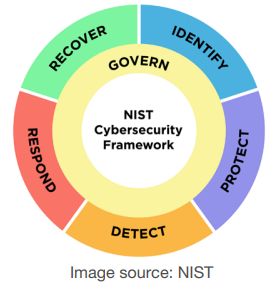In August 2023, the U.S. National Institute of Standards and Technology released a public draft of an updated Cybersecurity Framework with significant changes, including an emphasis on governance and supply chain risk management that align with Canadian legal requirements and regulatory guidance. The updated Framework will be an important benchmark resource for Canadian organizations of all kinds and sizes.
Background
The National Institute of Standards and Technology (NIST) is a U.S. Department of Commerce agency whose mission is to promote American innovation and industrial competitiveness. The NIST Cybersecurity Framework (the "CSF") provides guidance for managing cybersecurity risks by helping organizations understand, assess, prioritize, and communicate about those risks and the actions that will reduce them. The first version of the CSF, designed for use by critical infrastructure operators, was published in 2014. The current version, CSF 1.1, was published in 2018. In addition, in 2016, NIST published simplified cybersecurity guidance titled Small Business Information Security: The Fundamentals based on the CSF. See BLG bulletin Cybersecurity Guidance for Small and Medium Size Enterprises.
The CSF, particularly its "Framework Core", has been endorsed as a foundational cybersecurity resource by regulators and industry associations around the world, including in Canada. For example, the CSF Framework Core is reflected in the Investment Industry Regulatory Organization of Canada's Cybersecurity Best Practices Guide and Cyber Security Self Assessment, the BC Financial Services Authority's Information Security Guideline, the Mutual Fund Dealers Association of Canada's Cybersecurity bulletin, the Ontario Energy Board's Ontario Cyber Security Framework, and the Chartered Professional Accountants Canada's 20 questions directors should ask about cybersecurity.
Cybersecurity Framework 2.0
General
In August 2023, NIST announced a public draft of an updated Cybersecurity Framework 2.0 (CSF 2.0), a Discussion Draft of Implementation Examples, and a CSF 2.0 Reference Tool. NIST is accepting public comment on draft CSF 2.0 until November 2023, and plans to publish the final version of CSF 2.0 in early 2024.
NIST explained that draft CSF 2.0 reflects changes in the cybersecurity landscape and makes it easier for organizations in all sectors to implement the CSF. The significant changes include:
- A new title ("Cybersecurity Framework" instead of
"Framework for Improving Critical Infrastructure
Cybersecurity") and an expanded scope (providing cybersecurity
guidance for "any organization – regardless of its size,
sector, or maturity" instead of critical
infrastructure).
- A modified Framework Core (which describes the main
"functions" or "primary pillars" of a
successful and holistic cybersecurity program) with a new Govern
function in addition to the previous functions – Identify,
Protect, Detect, Respond, and Recover.
- Improved and expanded implementation guidance, including
examples and templates.
- Additional guidance for integrating cyber risk management with privacy risk management (including the use of NIST's Privacy Framework) and enterprise risk management.
New Govern Function
The new Govern function in draft CSF 2.0 Framework Core is a significant change. The function requires an organization to "[e]stablish and monitor the organization's cybersecurity risk management strategy, expectations, and policy", and "directs an understanding of organizational context; the establishment of cybersecurity strategy and cybersecurity supply chain risk management; roles, responsibilities, and authorities; policies, processes, and procedures; and the oversight of cybersecurity strategy".
Draft CSF 2.0 considers the Govern function to be cross-cutting because it informs how an organization will achieve and prioritize the outcomes of the other five functions of the Framework Core in the context of the organization's mission and stakeholder expectations.

The Govern function has the following six high-level "categories" (i.e., outcomes), each of which has numerous "sub-categories" (i.e., sub-outcomes):
- Organizational Context: The circumstances
– mission, stakeholder expectations, and legal, regulatory,
and contractual requirements – surrounding the
organization's cybersecurity risk management decisions are
understood.
- Risk Management Strategy: The
organization's priorities, constraints, risk tolerance and
appetite statements, and assumptions are established, communicated,
and used to support operational risk decisions.
- Cybersecurity Supply Chain Risk Management:
Cybersecurity supply chain risk management processes are
identified, established, managed, monitored, and improved by
organizational stakeholders.
- Roles, Responsibilities, and Authorities:
Cybersecurity roles, responsibilities, and authorities to foster
accountability, performance assessment, and continuous improvement
are established and communicated.
- Policies, Processes, and Procedures:
Organizational cybersecurity policies, processes, and procedures
are established, communicated, and enforced.
- Oversight: Results of organization-wide cybersecurity risk management activities and performance are used to inform, improve, and adjust the risk management strategy.
Supply Chain Risk Management
Draft CSF 2.0 explains that cybersecurity supply chain risk management is critical for organizations, and encourages the use of CSF 2.0 "to foster an organization's oversight and communications related to cybersecurity risks with stakeholders across supply chains". Draft CSF 2.0 addresses cybersecurity supply chain risk management in the "Cybersecurity Supply Chain Risk Management" category of the new Govern function by specifying the following desired outcomes:
- A cybersecurity supply chain risk management program, strategy,
objectives, policies, and processes are established and agreed to
by organizational stakeholders.
- Cybersecurity roles and responsibilities for suppliers,
customers, and partners are established, communicated, and
coordinated internally and externally.
- Cybersecurity supply chain risk management is integrated into
cybersecurity and enterprise risk management, risk assessment, and
improvement processes.
- Suppliers are known and prioritized by criticality.
- Requirements to address cybersecurity risks in supply chains
are established, prioritized, and integrated into contracts and
other agreements.
- Planning and due diligence are performed to reduce risks before
entering into formal supplier or other third-party
relationships.
- The risks posed by a supplier, their products and services, and
other third parties are identified, recorded, prioritized,
assessed, responded to, and monitored throughout the
relationship.
- Relevant suppliers and other third parties are included in
incident planning, response, and recovery activities.
- Supply chain security practices are integrated into
cybersecurity and enterprise risk management programs, and their
performance is monitored throughout the technology product and
service life cycle.
- Cybersecurity supply chain risk management plans include provisions for activities that occur after the conclusion of a partnership or service agreement.
Draft CSF 2.0 also encourages the use of NIST's Cybersecurity Supply Chain Risk Management Practices for Systems and Organizations (SP 800-161) to help manage supply chain cybersecurity risk.
Comment
CSF 2.0 will be an important cybersecurity benchmark resource that aligns with Canadian legal requirements and regulatory guidance regarding cybersecurity governance and cybersecurity supply chain risk management.
Cybersecurity Governance
The new Govern function in draft CSF 2.0 aligns with Canadian regulatory guidance that emphasizes the importance of a governance framework for effective cyber risk management. For example, the Office of the Superintendent of Financial Institutions' Guideline B-13 – Technology and Cyber Risk Management and Cyber Security Self Assessment, the Investment Industry Regulatory Organization of Canada's Cybersecurity Best Practices Guide, and the BC Financial Services Authority's Information Security Guideline.
The new Govern function also aligns with Canadian privacy commissioner guidance (e.g., Getting Accountability Right with a Privacy Management Program) and governance requirements imposed by recent amendments to Québec's private sector privacy law and the federal government's proposed new Consumer Privacy Protection Act. See BLG bulletins Québec Privacy Law Reform: Compliance Guide for Organizations and Canada's Consumer Privacy Protection Act (Bill C-27): Impact for businesses.
Cybersecurity Supply Chain Risk
Draft CSF 2.0's increased emphasis on cybersecurity supply chain risk management aligns with Canadian regulatory guidance that emphasizes the importance of managing cybersecurity risks arising from relationships with suppliers and service providers. For example, the Office of the Superintendent of Financial Institutions' Guideline B-10 – Third-Party Risk Management, the Investment Industry Regulatory Organization of Canada's Outsourcing Arrangements and Cyber Security Self Assessment, the BC Financial Services Authority's Outsourcing Guideline, and the Canadian Centre for Cyber Security's Cyber supply chain: An approach to assessing risk and Supply chain security for small and medium-sized organizations.
The content of this article is intended to provide a general guide to the subject matter. Specialist advice should be sought about your specific circumstances.

